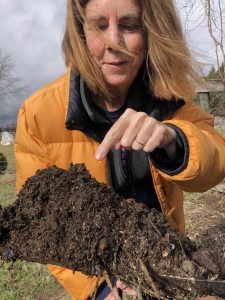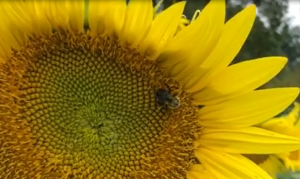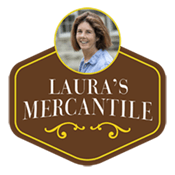When I asked this question to our regenerative farming team, the response back was, “Compared to what?”
The idea that we might behave like gardeners falls between two future visions: a rewilded paradise where people exit stage right; or a “precision agriculture” future, where food is grown in laboratories, enormous soil-less greenhouses, or dead dirt.
The rewilding idea comes from many corners. The most well-publicized narrative comes from Englishwoman Isabella Tree, whose Wilding: Returning Nature to our Farm tells a compelling story of a landowning family farming south of London. Rather than stay on the treadmill of industrial farming — chasing yields with farm chemicals and heavy tillage, losing money, facing bankruptcy — the owners of the Knepp Castle Estate jumped off that hamster wheel and set about using free-roaming animals to mimic the mega fauna of the past while leaving other plants and animals to do their thing. Plant life, bird life, insect life, mammal life returned. They developed markets for the beef and fruit which grew on the rewilded property. Now, the family is on the road to economic freedom, carbon is returning to the soil where it belongs, biodiversity is growing, and tourists can enjoy walks in nature.
In contrast, the fans of precision agriculture have grabbed this sound bite: use technology to stop climate change. With the right framing, this solution sounds good. Who isn’t for eliminating waste? Who isn’t for engineering brilliance? On the cusp of the pandemic, when I was in Washington to lobby our congressman about organic farming, emphasizing the dangers of climate change, chemical ag, and biodiversity loss, his immediate response was, “Precision ag! A trillion trees!”

Yes, I have a worm farm, and love my worms. In winter, they burrow in further to escape the cold, but thousands of worms live in my outside bin.
Like most people, I like precision and love trees, but what does this really mean? “Precision ag” involves taking out large bank loans to buy complicated equipment to place fossil-fuel derived fertilizer next; buying more equipment to spray ag chemicals to kill most everything but the seed and the plant; raising food in 60-acre soil-less fossil-fuel heated greenhouses, the plant nutrients coming from fossil-fuel derived liquid feed. Even more alarming to the natural farmer is manufacturing various versions of “Beyond Meat”–either lab-cultured meat cells ‘fed’ growth hormone produced from genetically modified fruit flies or cow uterus, or soy-based protein grown by cutting down Brazilian rainforests and spraying ag chemicals on plants genetically modified to withstand the poison.
As I enter my 41st year at Mt. Folly, we continue on the “middle way,” not rewilding and not growing food in a factory. We are going to try to be exceptionally good gardeners!
Many of the environmental writers I admire most are women. Their farming know-how begins in a garden rather than a GMO field of corn or at the winter farm machinery show. I’m talking about Joan Gussow and Anne Bilke, whose books we carry at The Mercantile on Main. I’m talking about my aunt, who led garden tours in England, and got me into Rosemary Verey’s early-fall vegetable garden. Rachel Carson, ground-breaking author of Silent Spring, tended plants and pollinators. And yet, at an organic soils seminar, I’ve overheard farmers telling each other that our test plot was “just a garden.”
Just a garden?
Charles Darwin, who sits in the firmament with Einstein, Isaac Newton and Galileo, spent his last years studying worms in his garden. Some contemporaries thought he was in his dotage; now thinkers (myself included) say he was continuing to shine as he computed how much soil worms could make by running vegetable matter through their gizzards.

Pollinators of all sorts of in decline. These sunflowers are certified-organic, which means there are no agriculture chemicals used to grow them. The sunflower seed is sold at The Mercantile on Main in returnable, refillable birdseed buckets.
Food production, packaging and distribution – the food system – is the world’s second largest emitter of greenhouse gases, trailing only the energy sector. Can we reverse that role instead, creating a system which sequesters carbon, restores species and diversity, and nourishes all? Can we remake Eden?
We are bound to try, and, yes, with God’s help and yours, I believe we can.
Last month, Mt. Folly Enterprises, the parent company for Laura’s Mercantile, The Mercantile on Main, and Wildcat Willy’s Distillery, was awarded a prestigious 5-year grant from the USDA to help farmers adopt practices that benefit the environment in measurable ways. By the end of the grant, many farms in the Ohio River Valley will be involved. Then, as now, Mt. Folly will be the farm on which our learnings (and our failings) are here for all to touch, watch and report.
Nothing about this project is boring, though I’m most excited about proving that food grown or raised at Mt. Folly is more nutritious and sustains our microbiome. I am also thrilled to demonstrate that mob-grazing cattle is a keystone practice for restoring the health of the soil and ourselves.
Please stay in touch. Follow us on social; sign up for the farm newsletter; book a stay at the Homestead log cabin; come talk with us at The Mercantile on Main. Thanks for learning and supporting innovative farming. Thanks for supporting plant-based medicines. We hope to see you soon.






